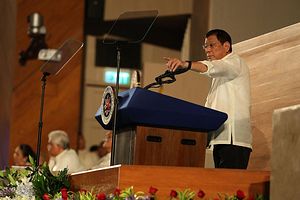On Tuesday, two Russian warships arrived in the Philippines for a goodwill visit in the latest sign of warming ties between the two countries.
This is not the first time that Russian vessels have docked in the Philippines. Philippine Navy Commodore Francisco Cabudao, who led the welcoming ceremony for the ships, confirmed to reporters that they had done so twice before, with the last one in 2012, in spite of earlier reports that had emphasized the unprecedented nature of the interaction.
Nonetheless, the four-day visit by a Russian anti-submarine ship, Admiral Tributs, and sea tanker Boris Butoma, has naturally turned heads. Russia, ambitious abroad but increasingly isolated from the West, has been looking to boost its presence in the Asia-Pacific, including in Southeast Asia. And though the Philippines has traditionally been a U.S. ally, Moscow no doubt senses new opportunities with Philippine President Rodrigo Duterte, who has been seeking to diversify Manila’s relationships away from Washington and toward others, especially Beijing and Moscow.
Though rhetoric by both sides still significantly outpaces reality in the Philippines-Russia relationship, there have been concrete steps taken to actually follow through on this. Duterte had sent his foreign and defense ministers to Moscow to explore potential opportunities to boost military-to-military ties. Following his return from the trip, Philippine Defense Secretary Delfin Lorenzana said that while Moscow had expressed a keen interest in advancing defense ties across the board, including selling equipment to Manila, the Philippines would be open to only some arms sales, in line with its own defense needs, capabilities, and budget availability. Equipment such as drones or sniper rifles, Lorenzana said, would be more likely than big-ticket items like submarines, and purchases are still being mulled.
The visit of the warships is yet another sign of the potential for burgeoning Philippines-Russia defense cooperation, even though it is still early days. The engagements during the visit itself are fairly standard: according to the Philippine Navy, they include tours to historical sites, ceremonies, capability demonstrations, shipboard tours, games between troops, and interactions with civilians.
But Eduard Mikhailov, deputy commander of Russia’s Pacific Fleet, was quite grandiose when speaking about Moscow’s ambitions for the future defense relationship. Apart from indicating that Russia stood ready to help the Philippines combat piracy and terrorism, Agence France-Presse quoted Mikhailov as saying that Russia was “very sure” that in the future, joint exercises focused on these areas would be carried out with varying degrees of complexity. Interestingly, Mikhailov also reportedly raised the prospect of joint exercises with other countries, including China and Malaysia, in the South China Sea.
“We really hope that in a few years, the military exercises for example in your region, in the South China Sea, will (involve) for example, not only Russia-Philippines, but Russia, Philippines, China, and maybe Malaysia together,” he said.
Mikhailov, who spoke through an interpreter, offered few specifics on what he meant, and given how often rhetoric surpasses reality in this relationship as well as the details that would be key in any such specific arrangement, that proposal should perhaps be seen as an aspiration rather than an actionable deliverable. Nonetheless, comments like this, as well as the engagements more broadly, do indicate the importance of paying attention to a defense relationship where most developments would have hardly been fathomable even a year ago.
































